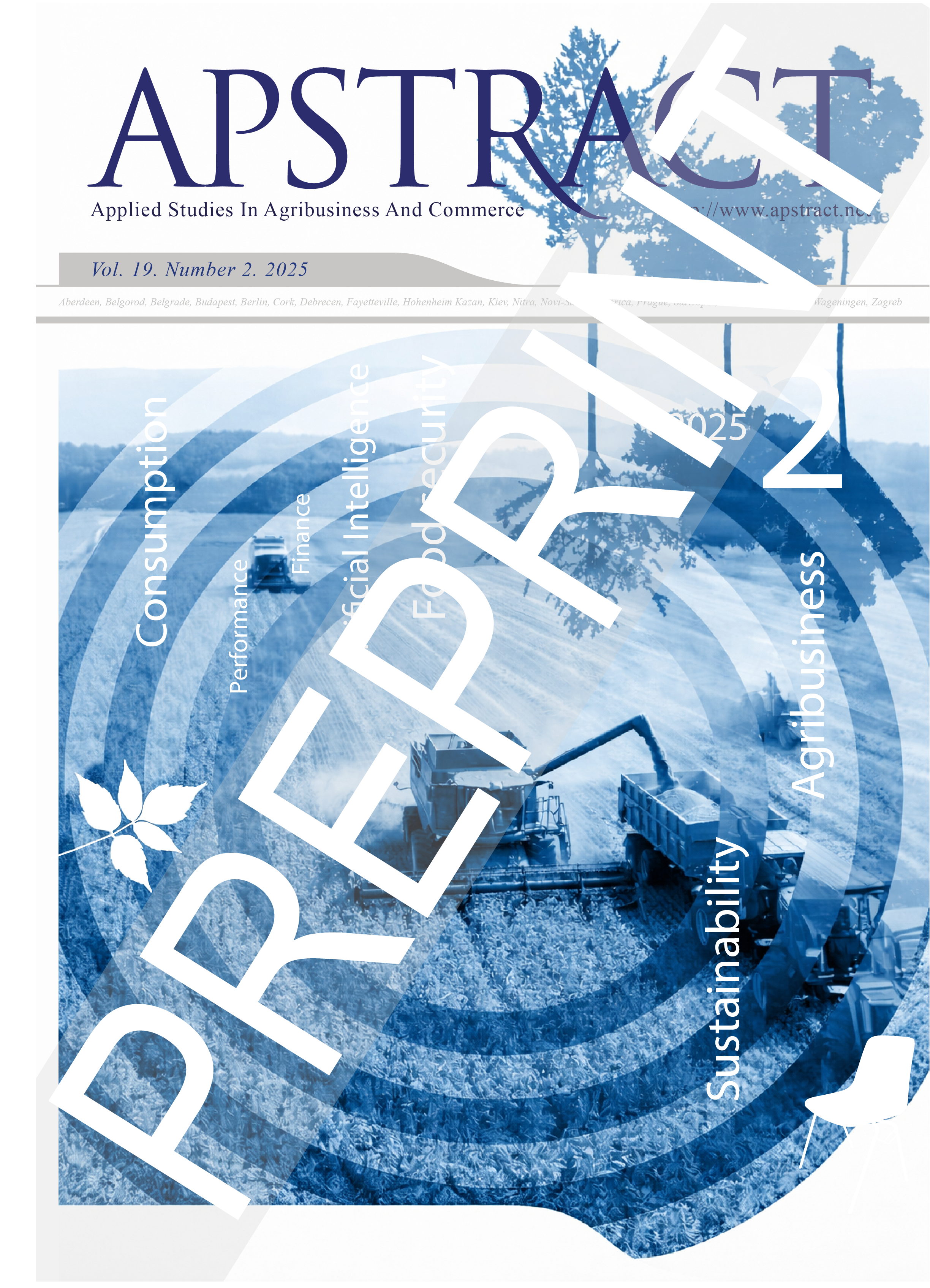Applied Studies in Agribusiness and Commerce (APSTRACT) is a peer-reviewed Open Access journal that publishes high-quality, practice-oriented research addressing key economic and managerial issues in agribusiness, commerce, and the global food chain. It serves as a scholarly platform for academics and professionals to disseminate innovative analyses, methodologies, and applications related to agricultural economics, environmental sustainability, and rural development. The journal particularly encourages studies with a strong empirical or methodological contribution that advance understanding in areas such as production economics, policy, marketing, international trade, and the agribusiness dimensions of the International MBA Network.
Publication: since 2007
The journal has been indexed in DOAJ since 2018.
Hungarian Academy of Sciences (MTA) rating: Section IV – Agricultural Sciences: A
The journal transitioned from the initial OJS implementation to the university’s publishing platform, utilizing all workflow features offered by the system — from author registration and manuscript submission to the peer review and editorial processes.
Quantifiable journal metrics
Citations:
- Scopus
- Web of Science
- Crossref
- MTMT (Hungarian Scientific Bibliography)
Applied Studies in Agribusiness and Commerce (APSTRACT): An internationally recognised journal of business and commerce ISSN : 1789-221X, electronic version: ISSN 1789-7874 have been listed on the IDEAS/RePEc.
All of our articles and Issues are available in the following repositories: AgEcon Search and University of Debrecen Electronic Archive. Our Journal DOI name is: 10.19041/APSTRACT
Vol. 19 No. 2 (2025): APSTRACT Current Issue
Full Issue
##issue.tableOfContents##
Articles
-
CURRENT ISSUES IN THE TRAINING SYSTEM OF THE MASTER OF BUSINESS DEVELOPMENT PROGRAMME IN THE LIGHT OF THE FEEDBACK OF THE PROGRAMME LEADERS
Views:18Over the past decades, business schools' Masters in Entrepreneurship Development have become one of the most important venues for training future entrepreneurs worldwide. The concept of entrepreneurship and the role of the entrepreneur has been in a constant state of flux over the years, with a significant impact on the structure, methodology and objectives of training courses. Universities need to focus not only on providing traditional business skills but also on developing competences adapted to an increasingly changing economic and social environment.In this article, after reviewing the most important foreign and domestic literature on the topic, we examine the current situation of Master's programmes in business development in Hungary through qualitative research. We focus on the social and economic changes that have influenced the development of entrepreneurship education in recent years and on the trends that may shape the content and form of education in the coming period. The research will use in-depth interviews with programme leaders to find out what expectations different stakeholders - labour market actors, university leaders, students and external stakeholders - have of the Master's in Business Development. We will explore the entrepreneurial competences and effective educator roles that are seen as key today, as well as the main challenges that programme leaders of training courses are currently facing. Based on this, this paper aims to identify potential opportunities and directions for improvement in the teaching of Masters in Business Development, which can contribute to preparing students more effectively for the challenges of a dynamically changing economic environment.
PDF1 -
ACCESS TO CREDIT AND ITS INFLUENCE ON COCOA FARMERS’ WILLINGNESS TO PAY FOR EU-APPROVED PESTICIDES IN ONDO AND OSUN STATES
Views:17This study investigated the effect of credit access on cocoa farmers’ willingness to pay for EU-approved pesticides in Osun and Ondo State, Nigeria. A multi-stage sampling procedure was employed to select 240 cocoa farmers for the study. Data collected were analyzed with the aid of descriptive statistics, contingent valuation method and logit regression model. The results for the entire respondents showed average values of 46 years for age, 23 years for years of experience, 7 persons for household size, and 8.54 hectares for farm size. The majority (83.3%) of the farmers used Redforce. Given the current standard mean price of N365 per litre, the majority (62.5%) of the cocoa farmers are willing to pay 25% (price between N 365 – N 466) more on the actual price of the EU-approved pesticides. Logit regression estimates showed that gender, age, marital status, education, extension visit, access to credit, household size, farm size, and quantity of pesticide used significantly influenced cocoa farmers’ willingness to pay for EU-approved pesticides. This study concluded that credit access is an important variable affecting cocoa farmers’ willingness to pay for EU-approved pesticides. This suggests that policy strategies aimed at improving the cocoa farmers’ willingness to pay for EU-approved pesticides must consider their credit access. Based on the findings of the study, it was recommended that Government and agricultural-related organisations should provide credit to farmers to boost their willingness to pay for the approved pesticides.
PDF0 -
OPTIMISING PUBLIC HEALTH OPEX: A CONCEPTUAL SYSTEMATIC REVIEW OF HEALTH SECTOR AND RURAL DEVELOPMENT STAKEHOLDER MANAGEMENT IN KENYA
Views:26The African Health ecosystem is yet to optimize multi-stakeholder collaborative efforts for desired outcomes in health-care interventions. Despite heavily relying on multiple sectors and developing progressive engagement frameworks, challenges in harnessing diverse stakeholder contributions to meet evolving health-care priorities persist within the sector. This situation exacerbates the challenge of health disparities, especially regarding regional and rural development. We seek to focus on Reversing the Hierarchical Overview of Public Health Stakeholders in Kenya by redesigning it to fit - a community and related stakeholders-centred Approach. We used the Conceptual Systematic Review to conceptualize the complexity of stakeholders’ ecosystem coordination. We use peer-reviewed literature and reports covering the stakeholders in public health. We coded the literature findings following the CSR stages. The study develops a proposed ecosystem map of stakeholders that incorporates suggested changes for improved local stakeholders’ coordination and local ownership of health investment activities in Kenya. The structuring and layering of the stakeholders will be informed by the tenets of the stakeholder salience model, thus advancing theoretical discourse in the area.
PDF0 -
ENHANCING AGRICULTURAL MARKET EFFICIENCY THROUGH THE INTEGRATION OF VALUE CHAINS INTO TANZANIA’S AGRICULTURAL COMMODITY EXCHANGE AND WAREHOUSE RECEIPT SYSTEM
Views:24Enhancement of small-scale agricultural performance is undoubtedly one of the Tanzanian government’s initiatives toward an industrialized economy as stipulated in “Intergrated Industrial Development Strategy 2025”. The coordination of agricultural commodity exchange market operations with those of warehouse receipt system was aimed at improving the forward market linkages for agricultural products from small-scale farming. However, due to the growth of the sector, it became imperative to review the marketing structure in place to align with the new changes. This study was conducted to assess a need of upgrading the marketing structure for small scale agribusinesses by focusing on sunflower sub-sector. Primary data were collected from 399 sunflower farmers from Kondoa and Itigi district councils based on cross-sectional survey design. The gross margin analysis revealed that, smallholder farmers engaged in sunflower oil business earned 5.085 times more than those who just sell unprocessed seeds. The secondary data from Tanzania corporation development commission (TCDC), Tanzania mercantile exchange (TMX) and warehouse receipt regulatory board (WRRB) showed that, the current marketing structure did not support the trading of processed agricultural products. It was therefore recommended to upgrade that system in place to have a designated window for trading the value added agricultural products for improved performance.
PDF0 -
TRUST AND TRADE READINESS IN THE AGRIBUSINESS SECTOR THROUGH INTERCULTURAL COMMUNICATION: INSIGHTS FROM A CONSULTANCY FIRM IN INDONESIA
Views:31In the era of global agribusiness, intercultural communication has become increasingly essential for fostering trust and facilitating international trade. This study explores how an Indonesian international consulting firm strategically applies intercultural communication to enhance trade readiness and build trust with global clients in the agribusiness sector. Guided by Communication Accommodation Theory (CAT), the research investigates convergence, divergence, and maintenance communication strategies across diverse cultural contexts, including East Asia, Australia, and the United States. Using a qualitative case study approach, data were collected through key informant interviews and direct observations of client-consultant interactions. The findings reveal that tailored communication, adjusted to cultural norms, client expectations, and technological platforms, plays a significant role in reducing misunderstandings and strengthening client relationships. Convergence strategies, such as mirroring tone and interaction styles, help establish rapport, while strategic divergence reinforces ethical standards and professional identity. Maintenance ensures consistency in service branding. The study concludes that intercultural competence is not merely a soft skill, but a strategic asset that improves trade outcomes, client satisfaction, and long-term partnerships in agribusiness. These insights offer practical guidance for consultants, business developers, and agribusiness firms navigating global markets. Future research may extend this analysis to comparative studies between regions or sectors to broaden understanding of intercultural dynamics in international trade.
PDF0 -
AGRIPRENEURSHIP AND WOMEN EMPOWERMENT IN CONFLICT-AFFECTED RURAL NIGERIA: DEVELOPMENT AND VALIDATION OF THE RURAL WOMEN AGRIPRENEURSHIP EMPOWERMENT INDEX (RWAEI)
Views:7The Rural Women Agripreneurship Empowerment Index (RWAEI), a multifaceted instrument for assessing the empowerment results of agripreneurial engagement among rural women in Northeastern Nigerian regions affected by conflict, is introduced in this study. The study examines how access to mechanization, farm production, hired labor, and market engagement contribute to long-term economic inclusion, decision-making authority, and community leadership in addition to job creation. It is framed within Sen's Capability Approach and Gendered Institutions Theory. The study uses confirmatory factor analysis (CFA), mediation analysis, and structural equation modeling (SEM) to validate the empowerment pathways and build the RWAEI model using data from 1,146 rural women in Gombe, Bauchi, and Adamawa. The findings show that the relationship between agripreneurship and empowerment is significantly mediated by labor employment and machine access.The index provides a context-specific metric for evaluating the agency and resilience of rural women, with a Cronbach's alpha of 0.812. The results back up the combination of focused capacity-building initiatives and gender-sensitive agricultural policies to increase the effect of agribusiness. By shifting from output-based models to capability-focused empowerment assessment, the study advances the conversation around agripreneurship and has wide ranging implications for poverty alleviation, post-conflict recovery, and the implementation of the Sustainable Development Goals (SDGs).
PDF0 -
GENDER-BASED FINANCIAL ACCESS IN LIBERIA'S FISHING INDUSTRY
Views:4One essential component of the competitive operation of the fishing industry is the availability of finance. Access to finance is an important issue, but women's access to finance is more critical than men's. The study's objective is to emphasize gendered experiences with financial need, access to and selection of financial services, and service providers among Liberian actors in the fish industry. The study collected and analyzed data using a cross-sectional design. The research used primary data collection methods. Workers in Liberia's artisanal fishing value chain, both men and women, were the main population of interest. Respondents were chosen for the study using a two-stage sampling technique. Purposive sample of counties and random sampling of respondents were the two components of the two-stage sampling strategy. For the study, 278 men and women fish actors were selected as respondents using the random sampling technique. This study employed quantitative methodologies for data collection. From the findings, access to financial products is generally limited for fish actors. Nonetheless, some financial services and products are exclusive to either gender. Commercial banks are more accessible to men than to women. Because of their low income and educational attainment, women have limited access to commercial banks.
PDF0 -
CONTRIBUTION OF COMMUNITY BASED ORGANIZATIONS IN ENHANCING RURAL COMMUNITY DEVELOPMENT: INSIGHTS FROM OSUN STATE, NIGERIA
Views:17This study examined the contribution of community-based organizations (CBOs) to rural community development in Osun State, Nigeria. Specifically, it described the characteristics of CBOs, identified their goals, types, and development projects, determined their contributions to rural development, and identified challenges limiting their performance. A multi-stage sampling procedure was employed to select 48 registered CBOs across the state, with 180 respondents. Data were collected through structured interview schedules and analyzed using descriptive statistics, while Pearson Product Moment Correlation (PPMC) was applied to test the study hypotheses. Results indicated that the mean years of formation of CBOs was 21.3 ± 9.5 years, majority had written constitution with a mean membership strength of 40±12 members. Primary goal of CBOs was economic empowerment of members (85.4%), The most prevalent CBOs included landlord associations and social groups. Most CBOs initiated erection of security gate at community entrance (75%) and provision of vigilante (70/8%). Provision of security for community and government property (mean = 2.83) and implementing of developmental projects (mean = 2.70) were s the most prominent contribution of CBOs. The major constraints affecting CBO performance were lack of funds (mean = 1.85) and lack of government support (mean = 1.51). Statistically significant relationships were observed between contribution and leadership tenure (r = -0.276, p ≤ 0.01), operational constitution (r = -0.406, p ≤ 0.01), and membership size (r = 0.299, p ≤ 0.05). The study concluded that despite the fact that CBOs contributed meaningfully to rural development, their potential remains constrained by limited institutional and community support. It is recommended that government should recognize and institutionalize the role of CBOs in rural development
PDF0 -
THE ROLE OF TRADITIONAL FARM RISK MANAGEMENT STRATEGIES ON REDUCING CREDIT RISK IN TANZANIA AGRICULTURAL LENDING
Views:24Agricultural financing enhances food security, job creation, a transition from subsistence to commerce farming, and strengthens the overall economy. However, due to unfavorable weather and market conditions there is limited financing directed towards agriculture especially in developing countries. Despite smallholder farmers' high adoption rate of traditional risk management strategies to minimize these risks, little has been done to examine its moderating role on the relationship between agricultural risks and credit risks. Thus, this study examines the role of farm business risk management strategies on minimizing the influences of production and market risk on smallholder farmers loan repayment capacity. The quantitative study used pooled cross-sectional data from a Tanzanian commercial bank from 2019 to 2021, covering 1,277 smallholder farmers from different administrative regions. Using binary interaction effect logistic regression analysis model, the study's results indicate that irrigation, mechanization, and off-farm diversification significantly minimizes the effects of production and market risk amongst smallholder farmers in Tanzania, an indication that traditional risk management strategies are effective tools amongst smallholder farmers. On the contrary, on-farm diversification strengthens the influence of production and market risk on loan repayment amongst the smallholder farmers in Tanzania, the results that can be influenced by a number of factors, including poor diversification knowledge among smallholder farmers. In light of these findings, the study recommends that policy makers and other development partners to develop agricultural infrastructure and provide more extension agents that can educate smallholder farmers on the best practices on traditional risk management.
PDF0 -
EXPLORING THE MEDIATION EFFECT OF PERCEIVED USEFULNESS ON CROP DIVERSIFICATION DRIVERS AMONG SMALLHOLDER COCOA FARMERS IN TANZANIA
Views:15The living standard of smallholder cocoa farmers in Tanzania was still low despite the recent transformation in marketing structure which led to the sharp rise in price. This study aimed at examining the drivers for smallholder cocoa farmers in Kilombero, Tanzania to engage in multiple crops farming as the means of poverty alleviation. Based on the cross-sectional survey design, primary data were collected from 501 cocoa farmers obtained through a random selection process that was conducted in their respective 162 agricultural marketing and cooperative societies (AMCOS) found in Kilombero. Results from covariance-based structural equation modeling (SEM) revealed that, cocoa market price, payment waiting time, farm size and cocoa farm income played significant roles in cocoa farmers’ decisions to invest while taking into account their perceptions of success. It was only the off-farm income factor that was found to have no statistical significance on farmers’ decision to invest while considering the mediation effect of perception. The study just assessed the investment decisions by smallholder cocoa farmers in Tanzania. Policy makers need to enhance the marketing factors such as cocoa price and payment time to boost farmers’ financial muscles. Meanwhile, farmers themselves are advised to take measures to boost production by increasing farm sizes while adopting better agronomic as per extension officers’ training.This study contributed to knowledge gap by exploring the cocoa-related factors that affect the stallholders’ decision to invest in crop diversification other than the non-cocoa factors that were investigated in previous studies.
PDF0 -
MONTE CARLO SIMULATION FOR STRESS TESTING ENDOGENOUS PROFITABILITY FACTORS DURING POLYCRISIS: A CASE STUDY FROM THE POULTRY SUBSECTOR
Views:19Can historical company data help estimate future performance during economic uncertainty? This study investigates whether past business cycles can be used to estimate profitability in the context of a polycrisis – a period marked by overlapping disruptions such as avian influenza, COVID-19 trade restrictions, extreme weather events, and rising feed and energy prices. These shocks have severely impacted agro-related industries, such as poultry processing. Focusing on three Central European poultry processing companies, we use Monte Carlo simulations for stress testing their profitability for the 2023 period, aiming to support financial planning by analysing firm-specific, endogenous, management-controllable factors. Return on Sales (ROS) and Return on Equity (ROE) are used to evaluate profitability, incorporating variables such as euro exchange rates in the case of export-driven firms. Our results indicate that Company “A,” characterized by stable operations, had the lowest probability of negative ROE, while Companies “B” and “C” demonstrated greater volatility. We found that the model provides a good estimate of the factors affecting the companies’ profitability that are directly or indirectly reflected in their accounting data. Indicating that the test could be a valuable tool for supporting managerial decision-making in financial planning, though further refinements are needed to enhance accuracy.
PDF0 -
THE INFLUENCE OF COVERAGE ATTRIBUTES ON COMMUNAL FARMERS' WILLINGNESS TO ADOPT CATTLE INSURANCE IN LUPANE DISTRICT, ZIMBABWE
Views:28This study examines the role of coverage attributes specifically, their scope, clarity, and relevance in influencing the willingness of communal farmers to adopt cattle insurance. The research was guided by the Stakeholder Networking Theory. Employing a mixed-methods approach in Lupane District, Zimbabwe, the research utilized a sample of 219 communal farmers, selected via multistage sampling for quantitative data, and 25 key informants, selected using purposive sampling for qualitative data. The Probit regression analysis revealed a statistically significant positive coefficient of 0.242 (p<0.001) for the relationship between Coverage Attributes and Willingness to Adopt. This indicates that farmers' decisions are significantly driven by the comprehensiveness of covered risks and the simplicity of the policy's terms. The findings highlight that existing products fail to meet farmer expectations regarding risk coverage and ease of understanding. This study concludes that insurance schemes must be designed to be both comprehensive and user-friendly, providing practical insights for creating policies that are genuinely attractive and relevant to the specific needs of this vulnerable demographic.
PDF0 -
ECONOMIC ANALYSIS OF A COMPLEX PIG FARM
Views:10The objective of this study is, beyond presenting the production and economic indicators of a complex pig farm established as a brownfield investment, to analyze its cost-income and profitability relations. The Authors conducted their calculations based on primary data collection and a preliminary calculation model. The technological equipment of the presented pig farm is competitive at the European level, and its production indicators also show favorable results. The capital investment demonstrates adequate profitability, as the internal rate of return (IRR) is 12.35%, while the net present value (NPV) of the investment at the end of the 15th year is HUF 1.36 billion. According to the model, the results indicate that, on the one hand, the investment is capital-intensive, but at the same time, large-scale livestock farms equipped with similarly advanced technology are definitely necessary, as they greatly contribute to improving the sector’s efficiency. There is further potential for achieving competitive advantages through increasing economies of scale. Appropriate human resources with the necessary expertise, genetics, and feeding must accompany the technological advancement.
PDF0 -
THE CHANGES IN THE HUNGARIAN HIGHER EDUCATION SYSTEM DURING THE CHANGE OF REGIME – THE SPREAD OF CHURCH AND FOUNDATION RUN INSTITUTIONS
Views:4This study examines the transformation of the Hungarian higher education system during the change of regime (1989-1990), with particular emphasis on the spread of church- and foundation-run institutions. It presents the legal framework that enabled the establishment of non-state institutions, highlighting Act XXIII of 1990 and subsequent legislation. It uses statistical data to support the significant increase in the number of institutions and students in the non-state sector. It illustrates the different development paths of these institutions through case studies of Károli Gáspár Reformed University and Kodolányi János University. The article analyzes the socio-economic impacts of the changes, including social mobility, economic development, and educational equality. Finally, it reflects on the current challenges and future prospects of Hungarian higher education.
PDF0 -
INTEGRATING SERVICE VALUE CHAIN GOVERNANCE ON SMALL SUNFLOWER PROCESSING INDUSTRIES IN DODOMA, TANZANIA
Views:13Small-scale sunflower oil processors dominate Tanzania’s sunflower value chain but face persistent performance challenges. This study examines how service value chain governance – defined by factors such as transaction complexity, service characteristics, technological capabilities, market transparency, market structure, and institutional frameworks – influences the capabilities and performance of small sunflower processing industries in Dodoma. Drawing on global value chain and transaction cost economics theories, we hypothesize that high transaction complexity and service intangibility negatively impact processors’ technological and human resource capabilities, while robust technological capacity and market transparency improve logistics and marketing performance. A cross-sectional survey of 275 sunflower oil processors in Dodoma was conducted, and six multiple regression models were used to test each specific hypothesis. Results show that all six governance factors significantly affect the processors’ operational capabilities in the expected directions. High transaction complexity and service heterogeneity are associated with lower technological competency and workforce efficiency, whereas greater technological capability and market transparency yield improved logistical coordination and market access. Fragmented market structures (many small suppliers) correlate with weaker financial performance, and a strong institutional framework is linked to better regulatory compliance. These findings highlight critical governance-related barriers and enablers for small agro-processors. We discuss practical and managerial implications for improving value chain integration – including investing in technology, training, and policy support – and outline theoretical contributions.
PDF1






